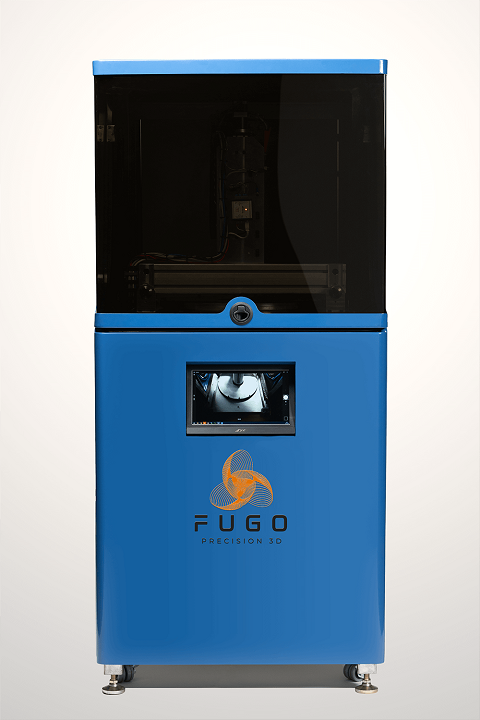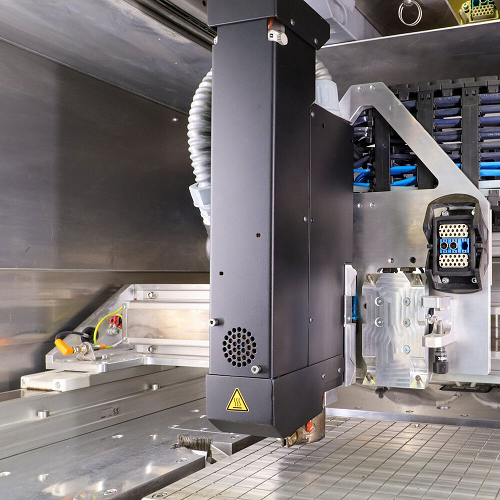In 3D Printing Information Briefs, an organization has launched what it says is the primary centrifugal 3D printer, AIM3D secured patents for pellet 3D printing, and micro-CT scanning is getting used for real-time print monitoring. Transferring on, Quickparts launched a brand new on-line software to streamline quantity manufacturing requests, and a US Air Power base put in a brand new 3D printer in its metals store. Lastly, researchers in Australia are 3D printing low-cost augmented actuality optical waveguides.
Fugo Precision 3D Launches Centrifugal 3D Printing Know-how

Fugo Mannequin A
At RAPID+TCT 2024 in Los Angeles, Fugo Precision 3D unveiled what it calls the world’s first centrifugal 3D printer, which is a significant milestone within the evolution of additive manufacturing. Now formally launched, the Fugo Mannequin A is alleged to supply patented “layerless” 3D printing with sub-30-micron accuracy, in addition to elevated velocity and throughput as much as ten instances sooner than conventional SLA 3D printers. The printer works with a number of functions and a variety of photopolymers, and the corporate is concentrating on high-volume producers that use 3D printing as a important aspect in manufacturing traces. The Fugo Mannequin A lowers prices and improves effectivity by integrating a number of post-production processes to streamline the workflow, so customers can supposedly print, wash, dry, and post-cure elements with out having to make use of a number of machines. Preliminary industrial manufacturing machines must be delivered in Q1 of 2024, and Fugo is now taking reservations for the Mannequin A.
“Because the creation of SLA and DLP expertise, the only biggest downside with these printers has been the necessity for a mechanical means to unfold the infinitely skinny layers,” stated Sasha Shkolnik, CTO of Fugo Precision 3D. “With the Fugo Mannequin A, we’ve got solved this downside as our expertise doesn’t use any mechanical means to create layers throughout printing.”
AIM3D Secures Patents in U.S. & Europe for 3D Pellet Printing

CEM extruder nozzle (nozzle sizes from 0.3 mm to 0.6 mm) for Examination 255 and Examination 510 from Purpose 3D
German 3D printing firm AIM3D, a College of Rostock spin-off, has secured patents in each the U.S. and Europe that defend its work in 3D extrusion printing. The corporate’s focus is pellet 3D printers, and the 4 patents cowl its composite extrusion modeling (CEM) expertise for high-temperature materials extrusion 3D printing, decentralized pellet extruders, and, within the U.S., its high-flow scorching ends and filament extruders. The patented CEM expertise permits for top construct charges and uniform extrusion, and is particularly efficient at processing ULTEM 9085, which is usually utilized in aerospace functions. The corporate’s industrial Examination 255 and Examination 510 printers can deal with ceramics, polymers, and metals, and have a price benefit over conventional FDM techniques, as they use commonplace pellets with or with out fillers. Plus, its Voxelfill technique addresses inhomogeneous strengths in 3D printing, which makes it attainable to realize lowered materials and weight, in addition to custom-made materials properties.
“The granted patents mirror our spectacular achievements in analysis and improvement. These patents safe our know-how for 3D pellet printers. On the similar time, we’re open to establishing licensing partnerships,” stated AIM3D’s CEO Dr.-Ing. Vincent Morrison.
Utilizing Dynamic Micro-CT for Actual-Time Monitoring of 3D Printed Elements

Determine 2. (high) load curve displaying measured power over instances; (backside) instance photos of every pattern at totally different instances throughout the check. Picture Credit score: TESCAN USA Inc.
Whereas 3D printing opens up many new prospects in superior manufacturing, it’s vitally vital to work on gaining a greater understanding of a 3D printed half’s efficiency whereas in operation—particularly when it’s confronted with exterior circumstances like loading or heating. Standard mechanical testing strategies present a basic overview of the half’s mechanical properties, however the impression can solely be decided by harmful strategies on the finish. A greater approach is dynamic micro-CT scanning, which permits uninterrupted information assortment and may be very helpful for non-destructive evaluation of the intricate geometries present in 3D printed elements. Just lately, the TESCAN UniTOM XL micro-CT was used for real-time monitoring and information acquisition in a examine of the adjustments that inside constructions of 3D printed plastic elements bear throughout compression loading.
Micro-CT scanning makes use of x-rays to gather 3D information, and utilizing the expertise in situ permits for a three-dimensional examine of processes inside a pattern half below altering exterior circumstances throughout mechanical testing. Information may be captured throughout your entire course of utilizing this technique, because of the excessive temporal decision that’s utilized by dynamic CT. A examine was performed of in situ 3D deformation of three plastic elements, every 3D printed with a special, widespread infill sample—Cross 3D, Dice, and Triangle. Whereas every pattern was constantly compressed, 220 tomograms had been captured over 22 minutes utilizing the TESCAN UniTOM XL micro-CT, with a voxel dimension of 59 µm and a temporal decision of 5.8 seconds per pattern rotation. The consumer was capable of be taught every kind of details about the inside constructions of the elements, equivalent to a transparent separation between particular person layers within the Cross 3D pattern because the load will increase; this might point out an absence of fusion between particular layers, which suggests the preliminary construct parameters must be transformed.
Quickparts Launches On-line Instrument to Streamline Quantity Manufacturing Requests

Quickparts offers prospects with a devoted workforce of undertaking, engineering and manufacturing workforce from the beginning of each undertaking
Customized manufacturing providers supplier Quickparts introduced a brand new on-line software, out there by means of its QuickQuote portal, that’s designed to streamline the request course of for quantity manufacturing. The user-friendly interface streamlines the whole lot and makes it straightforward for patrons to add information, enter particulars like supplies, design specs, and most well-liked processes, and submit the request. Then, a fast response is triggered from a devoted undertaking workforce, which lays the muse for discussions about buyer undertaking wants and customised quotes. The brand new software is aimed significantly at prospects with advanced or large-scale initiatives in injection molding, additive manufacturing, and CNC machining, and is only one extra instance of Quickparts’ persevering with dedication to quantity manufacturing capabilities.
“We’re thrilled to unveil this new on-line software. This revolutionary resolution simplifies the request course of for quantity manufacturing initiatives, enabling our prospects to obtain custom-made options that completely align with their particular wants,” stated Ziad Abou, Chief Success Officer for Quickparts. “At Quickparts, we’re devoted to delivering the aggressive edge our prospects want by offering distinctive service, unmatched high quality, and revolutionary manufacturing options.”
USAF Base Provides Stratasys 3D Printer to thirty first MXS Metals Store

U.S. Air Power Senior Airman Abram Reyes, thirty first Upkeep Squadron plane metals technician journeyman, checks upkeep elements of the thirty first MXS metals store Stratasys F900 3D printer at Aviano Air Base, Italy, July 12, 2024. (U.S. Air Power picture by Employees Sgt. Heather Ley)
The US Air Power Aviano Air Base has been utilizing 3D printing since 2019 in a number of items, together with the thirty first Upkeep Squadron (MXS). The thirty first MXS fabrication flight just lately added new capabilities to the metallic store within the type of a Stratasys F900 3D printer and related software program. Every year, the thirty first MXS fabrication flight produces about 63 native manufactured instruments and over 350 minor plane parts, with the assistance of a 3D printer within the Wyvern Spark Lab that may solely construct elements as much as 25.6 x 25.6 cm. However through the use of the brand new in-house Stratasys expertise on the metals store as a substitute, these numbers may majorly enhance by subsequent yr, because the F900 can print elements as giant as 91 x 91 cm. By 3D printing prototype molds for the elements first, they’ll simply return and redesign if there’s a difficulty, with out having to begin from scratch. John Bultman, College of Dayton Analysis Institute additive manufacturing engineer, visited the store and educated the Airmen to function, program, keep, and troubleshoot the printer.
“It opens a brand new and big selection of prospects sooner or later. Though it’s new right here, different bases have been utilizing this expertise for a number of years now and we’re very excited to have this functionality right here,” stated Senior Airman Abram Reyes, thirty first MXS plane metals technician journeyman.
Researchers 3D Printing Low-Price Augmented Actuality Waveguides

The tailored printing platform and the fabrication course of. Schematics illustrate the modified 3D printing platform. To boost gentle distribution uniformity, a diffuser and an absorber had been positioned in entrance of the sunshine supply. Moreover, one other diffuser was positioned on high of the LCD display screen. The highest and backside parts of the waveguide had been printed individually on glass printing beds and later built-in with the dielectric reflectors utilizing UV resin.
Utilizing a near-eye system, it’s attainable to create an interactive expertise—augmented actuality—by projecting digital data onto real-world objects. The AR area is common for enhancing leisure, and studying and manufacturing processes, but it surely’s not straightforward or low cost to mass produce the core light-transmitting parts in AR units known as waveguides. To resolve this downside, a workforce of researchers from the College of Melbourne designed a novel, low-cost method for manufacturing optical waveguides through the use of a modified LCD 3d printer. As they clarify of their paper, the researchers 3D printed parts of a geometrical AR waveguide, utilizing UV resin to bond three dielectric reflectors and different 3D printed elements. The workforce was capable of enhance floor roughness with out counting on dicing, molding, and post-polishing, which helps keep picture high quality of the waveguide whereas additionally lowering prices. They plan subsequent to discover superior supplies and printing strategies to boost the efficiency and sturdiness of AR waveguides.
“The intricate nature of conventional AR fabrication strategies and their excessive precision necessities for optical traits have develop into vital limitations to overcoming the price of mass manufacturing. The success of our prototype suggests potential for widespread software and commercialization,” defined writer Ranjith Unnithan.
Subscribe to Our E-mail E-newsletter
Keep up-to-date on all the newest information from the 3D printing trade and obtain data and gives from third celebration distributors.

